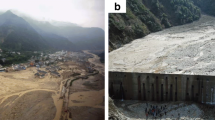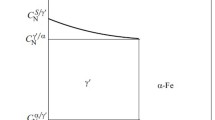Abstract
Formation of cellular detonation in a stoichiometric mixture of aluminum particles in oxygen is studied by means of numerical simulation of shock-wave initiation of detonation in a flat and rather wide channel. By varying the channel width, the characteristic size of the cells of regular uniform structures for particle fractions of 1–10 µm is determined. The calculated cell size is in agreement with the estimates obtained by methods of an acoustic analysis. A relation is established between the cell size and the length of the characteristic zones of the detonation-wave structure (ignition delay, combustion, velocity and thermal relaxation).
Similar content being viewed by others
REFERENCES
R. A. Strechlov, “Gas phase detonations: Recent developments,” Combust. Flame, 12, No.2, 81–101 (1968).
A. A. Vasil’ev, V. V. Mitrofanov, and M. E. Topchiyan, “Detonation waves in gases,” Combust., Expl., Shock Waves, 23, No.5, 605–623 (1987).
E. Oran, “The structure of propagating detonation,” in: G. Roy et al. (eds.), Gaseous and Heterogeneous Detonations, ENAS, Moscow (1999), pp. 97–120.
M. A. Nettleton, “Recent work on gaseous detonations,” Shock Waves, 12, No.1, 3–12 (2002).
K. I. Shchelkin and Ya. K. Troshin, Gas-Dynamics of Combustion [in Russian], Izd. Akad. Nauk SSSR, Moscow (1963).
V. V. Mitrofanov, Theory of Detonation [in Russian], Novosibirsk Univ., Novosibirsk (1982).
A. A. Vasil’ev and Yu. A. Nikolaev, “Model of the nucleus of a multifront gas detonation,” Combust., Expl., Shock Waves, 12, No.5, 667–674 (1976).
D. Desbordes, “Transmission of overdriven plane detonations: Critical diameter as a function of cell regularity and size,” in: Progress in Astronautic and Aeronautic, Vol. 114: Dynamics of Explosions, AIAAInc., NewYork (1988), pp. 170–185.
H. O. Barthel, “Predicted spacings in hydrogen-oxygen-argon detonations,” Phys. Fluids, 17, No.8, 1547–1553 (1974).
J. E. Shepherd, “Chemical kinetics of hydrogen-air-diluent detonations,” in: Progress in Astronautic and Aeronautic, Vol. 106: Dynamics of Explosions, AIAA Inc., New York (1985), pp. 263–293.
A. I. Gavrikov, A. A. Efimenko, and S. B. Dorofeev, “A model for detonation cell size prediction from chemical kinetics,” Combust. Flame, 120, 19–33 (2000).
B. A. Khasainov and B. Veyssiere, “Initiation of detonation regimes in hybrid two-phase mixtures,” Shock Waves, 6, 9–15 (1996).
B. Veyssiere and W. Ingignoli, “Existence of the detonation cellular structure in two-phase hybrid mixtures,” Shock Waves, 12, 291–299 (2003).
W. Ingignoli, B. Veyssiere, and B. A. Khasainov, “Study of detonation initiation in unconfined aluminum dust clouds,” in: G. Roy et al. (eds.), Gaseous and Heterogeneous Detonations, ENAS, Moscow (1999), pp. 337–350.
F. Zhang and H. Gronig, “Transition and structure of dust detonations,” in: A. A. Borisov (ed.), Dynamic Structure of Detonation in Gaseous and Dispersed Media, Kluwer Academic Publ. (1991), pp. 157–213.
B. A. Khasainov, B. Veyssiere, and W. Ingignoli, “Numerical simulation of detonation cell structure in hydrogen-air mixture loaded by aluminum particles,” in: G. Roy et al. (eds.), High-Speed Deflagration and Detonation, Fundamental and Control, ELEX-KM, Moscow (2001), pp. 163–174.
K. Benkiewicz and A. K. Hayashi, “Two-dimensional numerical simulations of multi-headed detonations in oxygen-aluminum mixtures using an adaptive mesh refinement,” Shock Waves, 13, 385–402 (2003).
A. A. Borisov, B. A. Khasainov, B. Veyssiere, et al., “Detonation of aluminum suspensions in air and oxygen,” Khim. Fiz., 10, No.2, 250–272 (1991).
M. Nikolis, D. N. Williams, and L. Bauwens, “Simulation of detonation cells in wide channel,” in: G. Roy et al. (eds.), Gaseous and Heterogeneous Detonations, ENAS, Moscow (1999), pp. 153–162.
L. Hemeryck, M. N. Lefebre, and P. J. Van Tiggelen, “Numerical investigation of transient detonation waves,” in: G. Roy et al. (eds.), High-Speed Deflagration and Detonation. Fundamental and Control, ELEX-KM, Moscow (2001), pp. 81–96.
W. A. Strauss, “Investigation of the detonation of aluminum powder-oxygen mixtures,” AIAA J., 6, No.12, 1753–1761 (1968).
A. E. Eremeeva, A. V. Medvedev, A. V. Fedorov, and V. M. Fomin, “On the theory of ideal and nonideal detonation of aerosuspensions,” Preprint No. 37-86, Inst. Theor. Appl. Mech., Sib. Div., Acad. of Sci. of the USSR, Novosibirsk (1986).
A. V. Fedorov, “Structure of heterogeneous detonation of aluminum particles dispersed in oxygen,” Combust., Expl., Shock Waves, 28, No.3, 277–286 (1992).
A. V. Fedorov, V. M. Fomin, and T. A. Khmel’, “Nonequilibrium model of steady detonations in aluminum particle-oxygen suspensions,” Shock Waves, 9, No.5, 313–318 (1999).
A. V. Fedorov and T. A. Khmel’, “Numerical simulation of shock-wave initiation of heterogeneous detonation in aerosuspensions of aluminum particles,” Combust., Expl., Shock Waves, 35, No.3, 288–295 (1999).
T. A. Khmel’and A. V. Fedorov, “Numerical simulation of detonation initiation with a shock wave entering a cloud of aluminum particles,” Combust., Expl., Shock Waves, 38, No.1, 101–108 (2002).
T. A. Khmel’and A. V. Fedorov, “Interaction of a shock wave with a cloud of aluminum particles in a channel,” Combust., Expl., Shock Waves, 38, No.2, 206–214 (2002).
E. L. Dreizin, “On the mechanism of asymmetric aluminum particle combustion,” Combust. Flame, 117, 841–850 (1999).
V. M. Boiko, V. P. Kiselev, S. P. Kiselev, et al., “Interaction of a shock wave with a cloud of particles,” Combust., Expl., Shock Waves, 32, No.2, 191–203 (1996).
A. Harten, “High resolution schemes for hyperbolic conservation laws,” J. Comp. Phys., 49, No.3, 357–393 (1983).
P. J. Roache, Computational Fluid Mechanics, Hermosa, Albuquerque (1976).
T. A. Khmel’, “Numerical simulation of two-dimensional detonation flows in a gas suspension of reacting solid particles,” Mat. Model., 16, No.6, 73–77 (2004).
Author information
Authors and Affiliations
Additional information
__________
Translated from Fizika Goreniya i Vzryva, Vol. 41, No. 4, pp. 84–98, July–August, 2005.
Rights and permissions
About this article
Cite this article
Fedorov, A.V., Khmel’, T.A. Numerical Simulation of Formation of Cellular Heterogeneous Detonation of Aluminum Particles in Oxygen. Combust Explos Shock Waves 41, 435–448 (2005). https://doi.org/10.1007/s10573-005-0054-7
Received:
Issue Date:
DOI: https://doi.org/10.1007/s10573-005-0054-7




